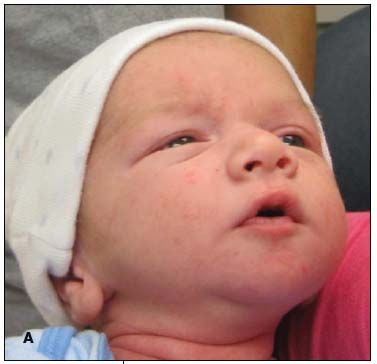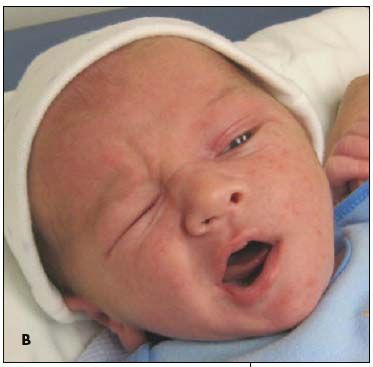Baby Boy Cries With One Eye Open
This 1-week-old baby boy was brought for his first newborn visit. The parents were concerned that when he cried, the left side of his face “does not move.”


HISTORY
This 1-week-old baby boy was brought for his first newborn visit. The parents were concerned that when he cried, the left side of his face “does not move” (see video below). He was born at full term via normal vaginal delivery to a primigravida without complications. Weight was 3.47 kg. Apgar scores, 9 and 9 at 1 and 5 minutes. Pregnancy and prenatal course were uneventful. Mother denied history of uterine tumors, multiple gestation, or polyhydramnios. No family history of neurological disorders or genetic syndromes.
PHYSICAL EXAMINATION
Vital signs normal. Weight, 3.51 kg; length, 49.5 cm; and head circumference, 34 cm. At rest, the infant's facial features appeared symmetric (A), with no bruising or obvious trauma. When he cried, the lower lip on the left side did not depress, the left eyelids remained open, the forehead and eyebrow did not wrinkle, and the nasolabial fold on the left was flat (B). He had normal suck and swallow reflexes and did not drool.
Mild positional plagiocephaly was noted in the right parietal area. Anterior fontanelle open, 2 × 2 cm, and pulsatile. Red reflexes intact bilaterally, with no obvious retinal hemorrhages. Two small subconjunctival hemorrhages noted in the right eye were coalescing around the iris and appeared to be of no clinical significance.
WHAT'S YOUR DIAGNOSIS?
ANSWER:CONGENITAL FACIAL NERVE PALSY
The reported incidence of congenital facial nerve palsy (CFNP) is 2.1 per 1000 live births.1 Although CFNP may be categorized in several ways, most cases can be classified as traumatic or developmental.
Traumatic CFNP. Trauma is the predominant cause of CFNP. The typical traumatic injury was thought to occur from a forceps delivery. However, intrauterine trauma can also occur during the latter stage of labor when a bony projection (such as the pubic rami, ischial spines, or sacral prominence) applies pressure on the infant's face.2 The facial nerve normally exits the skull through the stylomastoid foramen and travels through the parotid gland to the facial muscles. In newborns, the mandibular branch of the facial nerve courses along the edge of the mandible, leaving the nerve superficial and easily compressible.
Traumatic facial nerve palsy has a good prognosis; affected children recover fairly quickly within weeks or months after birth.3
Developmental CFNP. Nontraumatic facial nerve palsy is caused by an anatomical abnormality of the facial nerve nucleus or failure of the proximal facial nerve trunk to develop normally. Three presentations have been described:
• Unilateral supranuclear facial motor nerve abnormality, which causes contralateral weakness of all facial muscles, except those that wrinkle the forehead, close the eyelids, and dilate the nares.
• Abnormality in the proximal facial nerve trunk or nucleus, which causes ipsilateral, complete facial nerve paralysis, without sparing any muscle group.
• Partial peripheral facial motor nerve paralysis, which results in discrete facial asymmetry in the distribution of that branch.4
Palsy caused by a developmental condition is generally permanent and may be associated with other congenital malformations.
CLINICAL MANIFESTATIONS
CFNP manifests as the inability to wrinkle the brow, close the eyelids, maintain a nasolabial fold, and dilate the nostrils. The paralysis is apparent in all of the facial features on the affected side. The distinguishing feature in this case is that the eye does not close when the infant cries (see VIDEO below). In addition, the lower lip on the affected side does not depress normally with crying, which is similar to what is seen in infants with neonatal asymmetric crying facies (NACF).
DIFFERENTIAL DIAGNOSIS
CFNP may be confused with NACF (Table). The latter occurs in about 1 in 160 live births, although this number may be low because of the underreporting of mild cases.4 The hallmark of NACF is depression of one side of the lower lip with crying. The upper facial features (eyes, nose, and forehead) remain symmetric when the infant is either calm or crying.

NACF is often caused by hypoplasia of the depressor anguli oris muscle.5 It may be caused by obstetric trauma (from forceps delivery or intrauterine molding). In a study of 172 infants in which 51 were found to have NACF, the cause was obstetric trauma in 10 infants (20%) and hypoplasia of the depressor anguli oris muscle in 41 infants (80%)-6 of whom also had hypoplasia of the depressor labii inferioris muscle.6 Of the 41 infants, 5 had an associated congenital malformation.
ASSOCIATED SYNDROMES
The most well-known disorder that affects the facial nerve in a way similar to that of developmental CFNP is Moebius syndrome. This syndrome is extremely rare and affects the sixth and seventh cranial nerves. Its hallmark features include the inability to smile, frown, suck, grimace, blink, and move the eyes laterally. Infants with Moebius syndrome may also have skeletal problems, such as clubfoot, and swallowing difficulties. It was initially reported that one-third of children with Moebius syndrome have an autism spectrum disorder; however, this has been revised significantly downward with further studies.7 Developmental CFNP is also associated with Poland syndrome and Goldenhaar syndrome.8
MANAGEMENT
Asymmetric facies with crying should alert the clinician to either CFNP or NACF. Because most cases of CFNP are caused by trauma, it is prudent to monitor the infant for spontaneous resolution, especially when a congenital syndrome seems unlikely. Clinical signs of probable nerve compression/trauma are flattened parietal and temporal bones with a flattened mandible and a history that suggests compression in utero (eg, history of multiple gestation, large for gestational age infant, polyhydramnios, or uterine tumors).
When the clinician suspects a possible syndrome, a genetic consultation can be considered and genetic testing, such as a high-resolution chromosome analysis or a comparative genomic hybridization (CGH) array, can be ordered. When cardiac disease is present, consider fluorescence in situ hybridization analysis for microdeletion 22q11.2. In infants with a developmental cause of their facial palsy or NACF, there is only a 5% to 10% chance of finding a chromosomal abnormality or deletion; however, this will probably increase as CGH arrays are used more often and are enhanced.
When the cause of the palsy remains unclear, electrodiagnostic testing or ultrasonography can rule out hypoplasia of the depressor muscles.6 This can be useful for the clinician and the family for understanding whether the asymmetry will resolve, whether other tests would be useful, or whether surgical consultation is needed for an improved cosmetic outcome.4 MRI of the brain and temporal bone area can also be helpful in determining any other underlying anatomical anomaly.
OUTCOME OF THIS CASE
This baby boy was monitored for 6 months. He was noted to have slow, steady resolution of the facial palsy. The cause was thought to be a transient facial nerve compression injury from intrauterine positioning against his mother's pelvis.
Editor's Note: This video shows the infant crying.
References:
REFERENCES:
1. Falco NA, Eriksson E. Facial nerve palsy in the newborn: incidence and outcome. Plast Reconstr Surg. 1990;85:1-4.
2. Smith JD, Crumley RL, Harker LA. Facial paralysis in the newborn.
Otolaryngol Head Neck Surg. 1981;89:1021-1024.
3. Laing JH, Harrison DH, Jones BM, Laing GJ. Is permanent congenital facial palsy caused by birth trauma? Arch Dis Child. 1996;74:56-58.
4. Sapin SO, Miller AA, Bass HN. Neonatal asymmetric crying facies: a new look at an old problem. Clin Pediatr (Phila). 2005;44:109-119.
5. Miller M, Hall JG. Familial asymmetric crying facies. Its occurrence secondary to hypoplasia of the anguli oris depressor muscles. Am J Dis Child. 1979;
133:743-746.
6. Renault F. Facial electromyography in newborn and young infants with congenital facial weakness. Dev Med Child Neurol. 2001;43:421-427.
7. Briegel W, Schimek M, Kamp-Becker I, et al. Autism spectrum disorders in children and adolescents with Moebius sequence. Eur Child Adolesc Psychiatry. 2009;18:515-519.
8. Jamec B, Grobbelaar AO, Harrison DH. The abnormal nucleus as a cause of congenital facial palsy. Arch Dis Child. 2000;83:256-258.